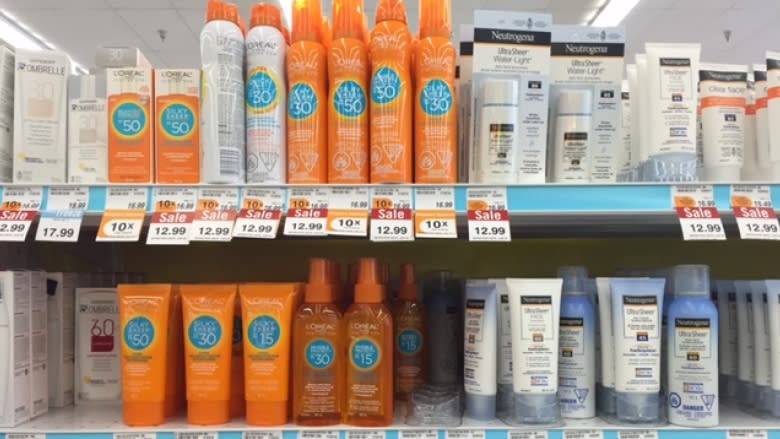Shady business: 10 tips to keep summer skin safe — even in RDF
A St. John's dermatologist is sharing his simple rule for preventing skin cancer: don't wait for sunny days to slap on the sunscreen.
"It doesn't have to be sunny. It doesn't have to be warm. You need sunscreen on cold, cloudy days," said Dr. Ian Landells of the Dr. H. Bliss Murphy Cancer Centre. He's been practising for 21 years.
Landells said people who believe the sun is a threat only on warm, sunny days are just plain wrong.
All about the UV
When it comes to cancer-causing UV rays, Landells says people in Newfoundland and Labrador are at a disadvantage. That's because from April to October, as the northern hemisphere leans closest to the sun, people in the province are exposed to larger doses of radiation — even when it's cold and cloudy.
"This past May, one day it was five degrees and the UV index was eight. That's very high," he said.
The UV index recommends sunscreen with a rating of three or higher.
Skin cancer on the rise
According to Landells, "95 per cent of skin cancers are caused from ultraviolet radiation of the sun or tanning beds."
And while skin cancer rates are increasing — partly because of early diagnosis — he said most skin cancers are very treatable if caught early.
Melanoma, however, is the most deadly form of skin cancer. Landells said it has to be diagnosed early in order to prevent the cancer from spreading through the body.
"In this province, we see melanoma in people who work outdoors, who work in gardens, postal carriers, people who work in forestry," he said.
Landells said he's spent much of his career dispelling myths about the sun. Here are some of the key points he shared during an interview on CBC Radio's CrossTalk.
1. What sunscreen is best?
Landells recommends using a sunscreen with a minimum SPF of 30.
"Sixty SPF is better than 30. Sixty is twice as as good as 30. It means you can stay out longer."
"I use 60. That's all I use," he added.
And if you're unsure about what to buy, Landells said to "look for the Canadian Dermatology Association logo on the packing. It means a minimum SPF of 30."
2. How much should I slap on?
According to Landells, if you're just squirting on a little sunscreen, you're wasting your time. That's because studies have reportedly shown that two-thirds of people don't apply enough.
"You need a half a teaspoon on your face. A half a teaspoon for each arm. You need a teaspoon for each leg and one for the back and front. That's a lot more than most people apply," he said.
For those using a spray, Landells warns it's not enough to spray the product into the air and "walk through" like a cologne.
"You have to spray it on the area and then you have to rub it in."
3. When should I apply?
Landells said people should wait 10 or 15 minutes after applying before stepping outside. From there, it's important to reapply the product after a couple of hours.
"Every two hours you should put some more on," he said.
4. What about water?
Landells warns to be extra cautious when water is around.
"Water almost doubles the amount of UV radiation that's hitting your skin. It's hitting you directly and it bounces off the water and hits you again. Double the dose."
Always reapply sunscreen when you step out of the water — even when wearing waterproof lotion.
"'Waterproof' or 'water-resistant' means it doesn't rinse off instantly when you enter the water."
5. The myth of the 'healthy' tan
"A tan is not a good thing." said Landells. That's because a tan is indicative of DNA damage — the body's defence mechanism against radiation damaging its cells.
"The concept of getting a little colour, is like saying, 'I'm just going to damage my DNA a bit," he said.
"It's like saying, 'I'm only going to smoke on the weekend.' It's the same concept — and it's not a good thing."
6. What about windburn?
Landells said, quite simply, there's no such thing as a windburn.
"That's a sunburn on a cloudy, cold day when you don't think it's sunny enough to actually get a sunburn."
He stressed that when the UV index is three or above, you need to wear sunscreen.
"There's only been a handful of days since the beginning of April that we have not needed sunscreen. All but five days in the last two and half months, you've needed sunscreen. Nobody thinks that here," he said.
7. What to wear
While layering up can help, Landells said even wearing extra clothes can't stop the sun from burning your skin.
"A dark T-shirt blocks more light than a white T-shirt. But if a white T-shirt gets wet, ultraviolet rays get through."
Landells said some specially designed clothes come with added SPF protection, and even work when wet.
A hat, he said, "does more than protect your head. It protects your nose and your temples, your ears [and the] sides of your neck."
8. On the road
And if you think you're safe from the sun inside your car, Landells said to think again.
"I see people coming in and they got all these little skin cancers along the left side of their face, and they drove for a living."
Unless a vehicle is outfitted with special UV-filtering glass, he said, UV rays are streaming through the windows. That means drivers are also at risk of developing skin cancer if they don't take measures to protect themselves.
9. But what about my daily dose of vitamin D?
Simply put, Landells said, get your vitamin D elsewhere.
"It's recommended that all Canadians take a vitamin D supplement," he said.
According to Landells, someone taking 1,000 international units of vitamin D per day will have "nothing to worry about."
He added that there's only so much vitamin D a body can produce when exposed to sunlight, and it's not possible for the vitamin to be stored for later use.
"Fifteen minutes on your hands and face three times a week is all the sun you need to have all the vitamin D your body can produce," he said.
Even those working outdoors during the winter months, he said, aren't getting enough UVB rays — the main cause of skin reddening and sunburn — to produce vitamin D.
"All Canadians need vitamin D supplementation."
10. When in doubt, ask an expert
Landells said if you're unsure about any changes to your skin, consult your family doctor.







